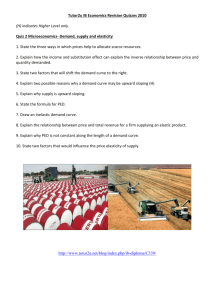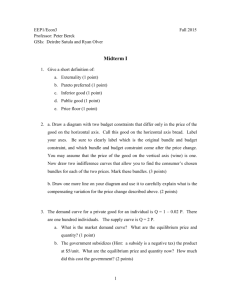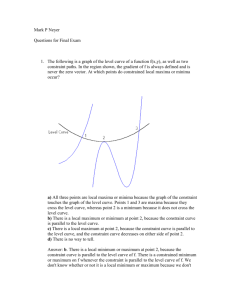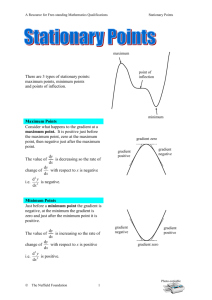uploads/5/3/5/9/53599889/eco_134_revision_notes_on_set_theory
advertisement
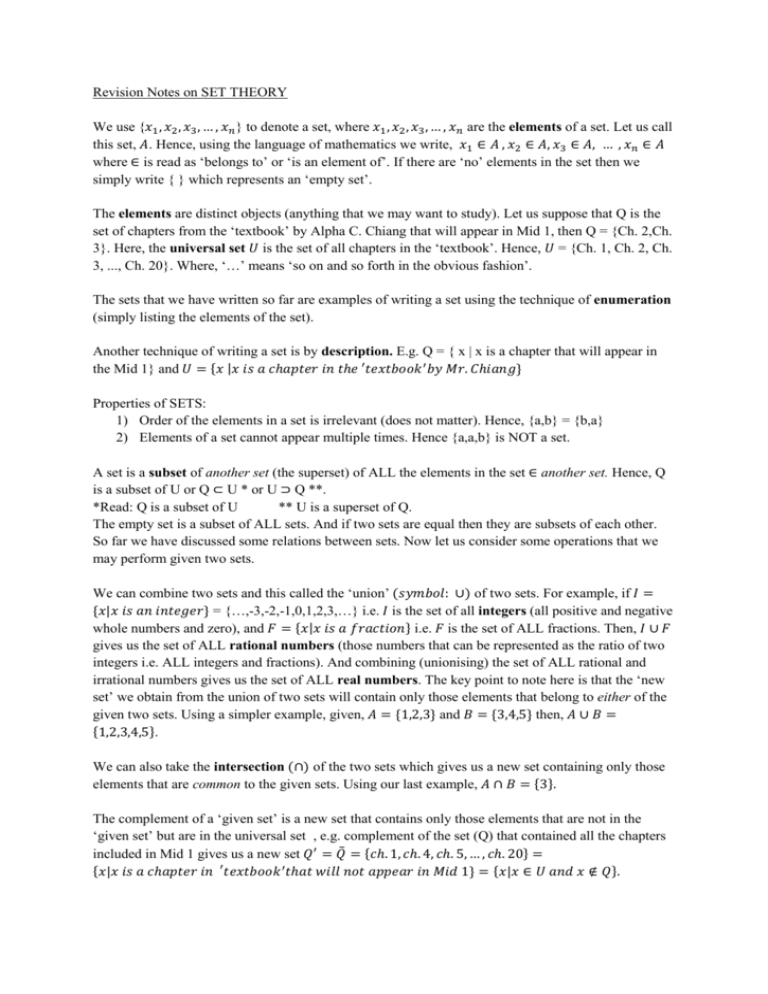
Revision Notes on SET THEORY
We use {𝑥1 , 𝑥2 , 𝑥3 , … , 𝑥𝑛 } to denote a set, where 𝑥1 , 𝑥2 , 𝑥3 , … , 𝑥𝑛 are the elements of a set. Let us call
this set, 𝐴. Hence, using the language of mathematics we write, 𝑥1 ∈ 𝐴 , 𝑥2 ∈ 𝐴, 𝑥3 ∈ 𝐴, … , 𝑥𝑛 ∈ 𝐴
where ∈ is read as ‘belongs to’ or ‘is an element of’. If there are ‘no’ elements in the set then we
simply write { } which represents an ‘empty set’.
The elements are distinct objects (anything that we may want to study). Let us suppose that Q is the
set of chapters from the ‘textbook’ by Alpha C. Chiang that will appear in Mid 1, then Q = {Ch. 2,Ch.
3}. Here, the universal set 𝑈 is the set of all chapters in the ‘textbook’. Hence, 𝑈 = {Ch. 1, Ch. 2, Ch.
3, ..., Ch. 20}. Where, ‘…’ means ‘so on and so forth in the obvious fashion’.
The sets that we have written so far are examples of writing a set using the technique of enumeration
(simply listing the elements of the set).
Another technique of writing a set is by description. E.g. Q = { x | x is a chapter that will appear in
the Mid 1} and 𝑈 = {𝑥 |𝑥 𝑖𝑠 𝑎 𝑐ℎ𝑎𝑝𝑡𝑒𝑟 𝑖𝑛 𝑡ℎ𝑒 ′𝑡𝑒𝑥𝑡𝑏𝑜𝑜𝑘 ′ 𝑏𝑦 𝑀𝑟. 𝐶ℎ𝑖𝑎𝑛𝑔}
Properties of SETS:
1) Order of the elements in a set is irrelevant (does not matter). Hence, {a,b} = {b,a}
2) Elements of a set cannot appear multiple times. Hence {a,a,b} is NOT a set.
A set is a subset of another set (the superset) of ALL the elements in the set ∈ another set. Hence, Q
is a subset of U or Q ⊂ U * or U ⊃ Q **.
*Read: Q is a subset of U
** U is a superset of Q.
The empty set is a subset of ALL sets. And if two sets are equal then they are subsets of each other.
So far we have discussed some relations between sets. Now let us consider some operations that we
may perform given two sets.
We can combine two sets and this called the ‘union’ (𝑠𝑦𝑚𝑏𝑜𝑙: ∪) of two sets. For example, if 𝐼 =
{𝑥|𝑥 𝑖𝑠 𝑎𝑛 𝑖𝑛𝑡𝑒𝑔𝑒𝑟} = {…,-3,-2,-1,0,1,2,3,…} i.e. 𝐼 is the set of all integers (all positive and negative
whole numbers and zero), and 𝐹 = {𝑥|𝑥 𝑖𝑠 𝑎 𝑓𝑟𝑎𝑐𝑡𝑖𝑜𝑛} i.e. 𝐹 is the set of ALL fractions. Then, 𝐼 ∪ 𝐹
gives us the set of ALL rational numbers (those numbers that can be represented as the ratio of two
integers i.e. ALL integers and fractions). And combining (unionising) the set of ALL rational and
irrational numbers gives us the set of ALL real numbers. The key point to note here is that the ‘new
set’ we obtain from the union of two sets will contain only those elements that belong to either of the
given two sets. Using a simpler example, given, 𝐴 = {1,2,3} and 𝐵 = {3,4,5} then, 𝐴 ∪ 𝐵 =
{1,2,3,4,5}.
We can also take the intersection (∩) of the two sets which gives us a new set containing only those
elements that are common to the given sets. Using our last example, 𝐴 ∩ 𝐵 = {3}.
The complement of a ‘given set’ is a new set that contains only those elements that are not in the
‘given set’ but are in the universal set , e.g. complement of the set (Q) that contained all the chapters
included in Mid 1 gives us a new set 𝑄 ′ = 𝑄̃ = {𝑐ℎ. 1, 𝑐ℎ. 4, 𝑐ℎ. 5, … , 𝑐ℎ. 20} =
{𝑥|𝑥 𝑖𝑠 𝑎 𝑐ℎ𝑎𝑝𝑡𝑒𝑟 𝑖𝑛 ′𝑡𝑒𝑥𝑡𝑏𝑜𝑜𝑘 ′ 𝑡ℎ𝑎𝑡 𝑤𝑖𝑙𝑙 𝑛𝑜𝑡 𝑎𝑝𝑝𝑒𝑎𝑟 𝑖𝑛 𝑀𝑖𝑑 1} = {𝑥|𝑥 ∈ 𝑈 𝑎𝑛𝑑 𝑥 ∉ 𝑄}.
The last operation on sets, we shall consider here, is that of the multiplication of two sets. When we
multiply two sets we get a new set containing ordered pairs (𝑥, 𝑦). In this case the ordered pairs are
the elements of the sets. The first variable ′𝑥′ of the pair MUST be from the first set and the second
variable ′𝑦′ MUST be from the second set. E.g. given, 𝐴 = {1,2} and 𝐵 = {3,4,5} then, 𝐴 × 𝐵 =
{(1,3), (1,4), (1,5), (2,3), (2,4), (2,5)}.
We have already seen an application of SET THEORY where we used it to derive the set of all real
numbers. If we represent the set of all real numbers on a straight horizontal line then we get the real
line (x axis) and if we represent take another vertical real line (y axis) which intersects the horizontal
real line at ‘0’ then we get the famous rectangular (Cartesian) coordinate plane, which is used to
perform graphical analysis of the relationship between two variables in almost every field of study
imaginable…
Some BASIC CONCEPTS related to the rectangular coordinate plane:
If you see a line or curve (drawn in the rectangular plane) that is upward sloping (red line/supply
curve in the figure below) then this means the variables are directly related (as one variable increases
so does the other). In the figure below, as the quantity increases (as you move right along the
horizontal axis), the price increases as well…vice versa.
A downward sloping curve or line indicates that the variables are inversely related (as one increases
the other decreases). Hence the demand curve in the figure below is downward sloping, since price
and quantity demanded is inversely related…as one increases the other decreases.
Source: www.faculty.washington.edu/danby/bls324/surplus.html
The rate of increase or decrease is given by the gradient of the line or curve where
𝑔𝑟𝑎𝑑𝑖𝑒𝑛𝑡 =△ 𝑦/△ 𝑥 .
For example, in the figure above when quantity supplied changes from 0 to 5 units the price increases
5
from $0 to $ 5. Hence, Δ𝑥 = 5 − 0 = 5 𝑎𝑛𝑑 Δ𝑦 = 5 − 0 = 5, gradient= 5 = 1. When the quantity
demanded changes from 0 to 5 units then the price drops from 10 to 5 units. Here, Δ𝑦1 = 5 − 10 =
5
−5. Therefore, gradient = − 5 = −1.
1
Change = Final value – Initial value
